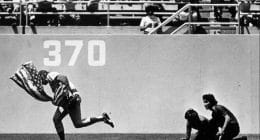The Los Angeles Dodgers have boasted one of the best offenses in Major League Baseball since the All-Star break, with notable contributions coming from the likes of Yasmani Grandal, Howie Kendrick and Corey Seager.
While the trio has garnered the most attention, another key member of the lineup that has also helped bolster the offense is center fielder Joc Pederson.
He’s in the midst of his most productive season as a big leaguer since debuting in September 2014, and hasn’t shown any signs of encountering the dreaded “sophomore slump” whatsoever.
Entering play on Tuesday, the 24-year-old ranks fifth in wRC+ (128) and slugging percentage (.508), sixth in wOBA (.360) and seventh in home runs (18) among center fielders with a minimum of 300 plate appearances.
More impressively, Pederson has smoothly rebounded from the brutal second half he endured during his rookie season in 2015.
It was a stretch in which he posted a slash line of .178/.317/.300 with just six home runs in 62 games, compared to an All-Star first half where he hit .230/.364/.487 with 20 home runs.
What have been the keys to Pederson’s bounce back campaign thus far? Let’s take a look at some deciding factors and improvements he’s made over the course of a calendar year.
Less strikeouts, more contact
Last season Pederson struck out in roughly 29 percent of his plate appearances, which was the fifth-highest mark in MLB. Only Chris Davis, Michael Taylor, Kris Bryant and Ian Desmond whiffed at a higher rate among qualifiers.
This season, he has lowered that rate to about 25 percent, which doesn’t even land him in the top-30 for that category (minimum 300 plate appearances). Pederson has also cut back on his swing-and-miss rate from last season: 14 percent to 9.7 percent.
In addition to striking out less, Pederson has significantly made more contact when he swings the bat this season. Since the beginning of 2015, his contact percentage has increased exactly by 10 points (66.7 percent to 76.7 percent).
When Pederson puts the ball in play, he’s driving the ball more times than not. Going back to last season, his soft contact percentage has decreased from 20.4 percent to 18.1 percent in 2016, and his combined medium contact and hard contact percentage of 79.7 percent has increased to 81.9 percent.
BABIP has regressed to the mean
While Pederson vastly struggled with strikeouts last season, he was also very unlucky with his batting average on balls in play — his .262 mark was well below the league average of .300, which helps explain why he batted just .210 for the year.
This season, however, Pederson’s BABIP has drastically increased to .291, with more of his batted balls becoming hits rather than outs, and therefore, raising his overall batting average to a more respectable .251.
Not as much playing time against left-handed pitchers
Pederson was an everyday player for a large chunk of 2015 and that hasn’t exactly been the case this season. He has received just 46 plate appearances against southpaws this season, recording four hits and drawing six walks.
While one can make a case that a young player like Pederson should get more exposure to left-handed pitching, he has thrived in a platoon role of sorts — batting .272/.360/.552 (144 wRC+) with 17 of his 18 homers coming against right-handers.
With the Dodgers’ offense clicking at an ideal time as the San Francisco Giants continue their second-half swoon, Pederson has played a huge part in reviving what is now one of the National League’s most potent lineups.
Even though he might not face as much scrutiny as he did a year ago, Pederson has certainly been of the most underrated players in the Majors this season — and his numbers back that up in a big way.





